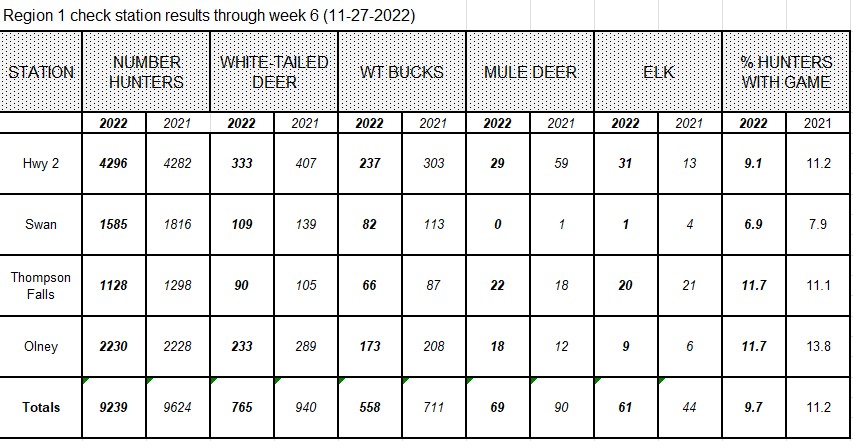More than 9,200 hunters appeared at game check stations in northwest Montana. The overall number of hunters with harvested elk was up compared to a year ago while the number of hunters with deer was down. A table below summarizes the results at four check stations this season.
The counts at the stations represent a sampling of the harvest and do not represent the complete number of animals taken. Hunter-harvest telephone surveys, conducted over the upcoming winter months, will provide more harvest data and information for biologists.
Many of Montana’s Wildlife Management Areas have seasonal closures from Dec. 2 through May 15 at noon to protect big game winter range. For more information, visit https://fwp.mt.gov/conservation/wildlife-management-areas.
While the general hunting season ended last weekend, hunters will still have opportunities into winter. Certain areas have continued elk hunting opportunities, and there is also Montana’s muzzleloader heritage hunting season for deer and elk, Dec. 10-18, 2022.
Muzzleloader Heritage Hunting Season
- A person may take a deer or elk with a license or permit that is valid on the last day of the general hunting season.
- Any unused license-permit valid on the last day of the general season (i.e., Nov. 27, 2022) is valid during the muzzleloader heritage season.
- Hunters can use plain lead projectiles and a muzzleloading rifle that is charged with loose black powder, loose pyrodex or an equivalent loose black powder substitute and ignited by a flintlock, wheel lock, matchlock or percussion mechanism using a percussion or musket cap.
- The muzzleloading rifle must be a minimum of .45 caliber and may not have more than two barrels.
- During the muzzleloader heritage season, hunters may not use a muzzleloading rifle that requires insertion of a cap or primer into the open breech of the barrel (inline), is capable of being loaded from the breech, or is mounted with an optical magnification device.
- Use of pre-prepared paper or metallic cartridges, sabots, gas checks or other similar power and range-enhancing manufactured loads that enclose the projectile from the rifling or bore of the firearm is also prohibited.
- Many of Montana’s Wildlife Management Areas have seasonal closures from Dec. 2 through May 14. Before heading to the field, hunters need to check the hunting regulations to make sure they are compliant. A list of WMAs and their seasonal closure dates is also available online.
Chronic Wasting Disease
Testing for chronic wasting disease (CWD) is voluntary throughout the state. FWP can assist hunters with sample collection and submission, or hunters can submit samples themselves.
For assistance in northwest Montana, hunters can bring their animal to the FWP office in Kalispell, Monday-Friday from 8 a.m. to 5 p.m. through the month of December.
FWP will cover the cost of testing hunter-harvested animals for CWD.
Hunters who want their animal sampled should leave 2 to 4 inches of the neck below the low jawbone and base of the skull to ensure lymph nodes are present and not inadvertently left with the carcass. Samples cannot be collected from frozen heads.
To help prevent the spread of CWD, all carcasses, including the head and spinal column, must be disposed of in a class II landfill after butchering and processing. Dumping carcasses is illegal, unethical and can spread diseases, including chronic wasting disease. This requirement applies to all deer, elk, and moose carcasses harvested by hunters or as vehicle-killed salvage.
Contact a Montana Fish, Wildlife & Parks regional office for more information. In northwest Montana, call (406) 752-5501.
